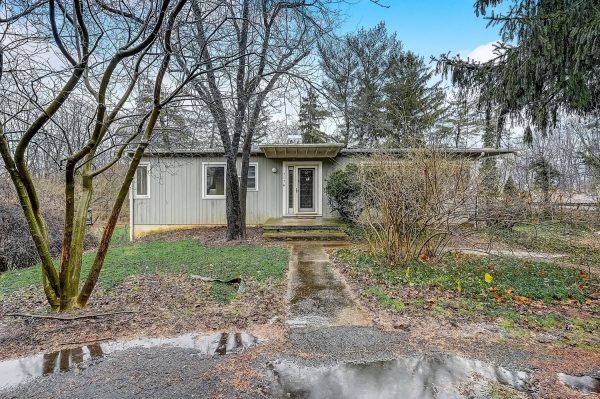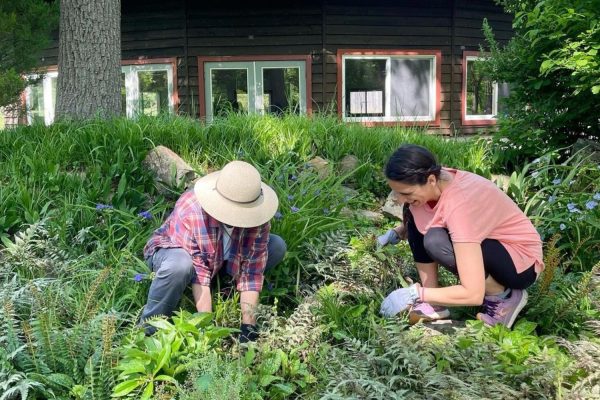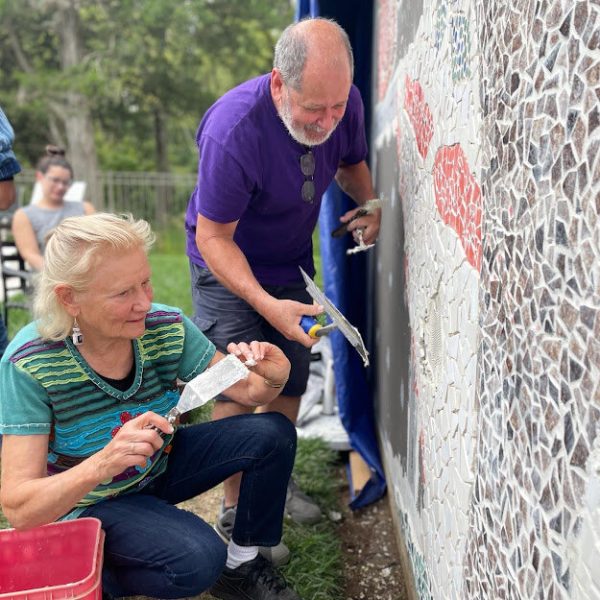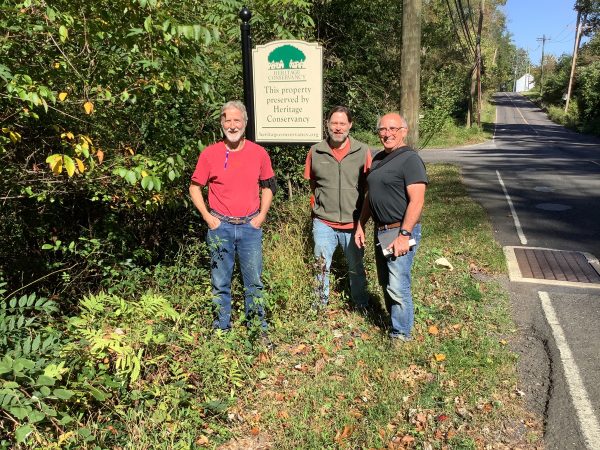The sight of thousands of fireflies flickering over the Bryn Gweled pond on a quiet summer evening took Cathie Forman’s breath away. It’s that feeling — and a respect for the living landscape that inspired it — she wants to pass down to future generations.
Bryn Gweled is more than just a place of natural beauty and strong community bonds. It is also Heritage Conservancy’s first conservation easement (settled in 1973) and a model for preserving a thriving natural environment.
The intentional community in Upper Southampton Township is widely considered an “oasis” in an increasingly developed suburban area. Residents and neighbors enjoy wandering through the thick woods, along streambanks and trails that make up the 45-acre easement.
“It’s our gift to future generations,” says Cathie. “It’s extremely important to think about what we are handing down to them.”
“As the first easement we acquired, Bryn Gweled sets an example for other property owners to help them think about how they can preserve their properties,” says Mary Lou McFarland, Heritage Conservancy’s Senior Preservation Specialist.

From left: Warren Edwards, Cathie Forman, and Hans Peters
Hill of Vision
Bryn Gweled is Welsh for “Hill of Vision” and its roots date back to 1939, when 13 Philadelphia families moved to the country together to form a community based on democratic principles and a respect for diversity. Most of the founding families were Quakers, but they were clear that the community was open to all, regardless of race, religion, or nationality.
In the spring of 1940, the families collectively purchased a 240-acre farm in Upper Southampton, incorporating as Bryn Gweled Homesteads, Inc. They divided 160 acres into leaseholds of about two acres each.
Many of the homes built on the lots were designed by students of Frank Lloyd Wright. Thirty-five acres are used for roads, community buildings, playing fields, a community garden, and open space.
The remaining 45 acres lie primarily along creek beds and in areas wooded with a variety of trees, shrubs, and other native plant species, some of which are quite unique.
Warren Edwards and his wife Debbie moved to Bryn Gweled 20 years ago. His professional background in horticulture and forestry, and a love of the outdoors, bolster his enthusiasm.
“As a horticulturist, I’ve found plants that grow here you won’t find in other suburban areas,” says Warren. “We have some unusual things here.”
Like the American Elm. The species was nearly wiped out by Dutch elm disease. On one of his frequent “woods walks” Warren spotted the tree and later planted a handful of American Elm seeds. He is delighted to see the trees growing.

Conservation Easement
For the last five years, Warren has served as the liaison to Heritage Conservancy. He works with Mary Lou on any issues and reports what Bryn Gweled is doing to support the health of the community’s green spaces.
“We value the easement,” says Warren.
A conservation easement is a voluntary legal agreement between a landowner and a land trust (like Heritage Conservancy) or agency that permanently restricts certain uses and activities in order to protect the conservation values associated with the property’s natural resources and wildlife habitat.
The easement ensures the land is permanently protected through all future changes in ownership. Once a property is protected with a conservation easement, experts from Heritage Conservancy offer landowners resources to help them steward their property.
“I love working with the property owners,” Mary Lou says. She monitors the property. “It’s a partnership. If they have questions they get in touch with me, and they let me know which projects they are working on. It’s nice to have that information coming from their side.”

A Working Community
Members of Bryn Gweled do not own the land, but are shareholders of the nonprofit Bryn Gweled Homesteads, Inc. Each member is expected to voluntarily contribute toward the maintenance of the community.
The 75 or so families who make up the community’s membership carry on the founders’ vision of cooperation and a common responsibility to restore and conserve the land, whether common areas or individual homesteads.
“The original founders were really visionary and forward thinking in many ways,” adds long-time resident Hans Peters. “And Bryn Gweled is pretty much still as the founders envisioned.”
His parents were among the early members of the community. Hans grew up there, moved away, and returned in 1973. His particular interest is in the health of the streams. Hans has completed the Master Watershed Steward program through Penn State Extension. Along with other volunteers, he makes a “community activity” out of taking water samples twice a year.
Hans serves on the Environmental Stewardship Committee, one of the most active of about two dozen volunteer committees that range from Assessment and Budget to Grounds and Planting to Children’s Activities.

Monthly “work parties” bring volunteers together to maintain the community’s roads, natural lands, and facilities like the community center or swimming pool. They are complemented by a slew of community events.
“I see it as a true functioning democracy and I find that refreshing,” says Cathie Forman. “It’s special because we still don’t have private land ownership, and that culture of community is maintained.”
Cathie embraces the community’s commitment to preserving nature, to “doing no harm – it’s an important commitment.” She raised her son and daughter there and says growing up in Bryn Gweled was a wonderful experience for them.
A retired school social worker with a Master’s in Community Organizing, Cathie moved to Bryn Gweled in 1993 and is a former board chair. She continues to volunteer with the Environmental Stewardship Committee.
“A respect for the land is really important to me,” she says. “Our members have different levels of knowledge and perspectives about the environment, but they come here with some type of wanting to live in nature. The ideal is there.”

Fertile Land for Community
The wooded areas, streams and pond attract fox, rabbits, flying squirrels, deer, bats, various reptiles and the rare bear. Warren has counted 100 different species of birds that land or fly over the community, including owls, raptors and hummingbirds.
“We’re doing a great thing by just setting this land aside. This land is not going to be used for building,” says Warren. It is “like a green stepping stone for migrating birds and animals.” It complements other nearby green spaces like those found at the Churchville Nature Center to the north and in Bryn Athyn to the south.
As liaison to Heritage Conservancy, he is able to “show off the positive things we’re doing.” This includes planting and nurturing more trees, clearing invasive species, protecting stream banks from erosion and educating community members about environmental issues like recycling.
“There is so much pleasure and friendship here. At Bryn Gweled, I get to be me,” says Warren, a self-described introvert who relishes opportunities to organize and participate in events with neighbors. The community affords a sense of “creative empowerment” to stage activities like summer concerts, backyard Shakespearean plays and educational woods walks.
For Cathie, a sense of connection comes from a shared desire to interact positively with the environment. Like those unforgettable fireflies. “We do things here to help fireflies and other creatures. I really like how that is important to people here.”
“Bryn Gweled is more than just a nice place to live,” adds Hans. “We’re an important green area in a sea of suburban development. The easement ensures in perpetuity that at least these riparian areas will never be developed.”
“It’s a proactive approach to property management,” says Mary Lou.
“It’s our responsibility to protect the land for generations to come. We have to do this for them,” says Cathie. “I see that Heritage Conservancy plaque and it makes me a little more hopeful.”
Learn more about Bryn Gweled Homesteads and Heritage Conservancy’s land conservation work.
Photos courtesy of Bryn Gweled Homesteads.
